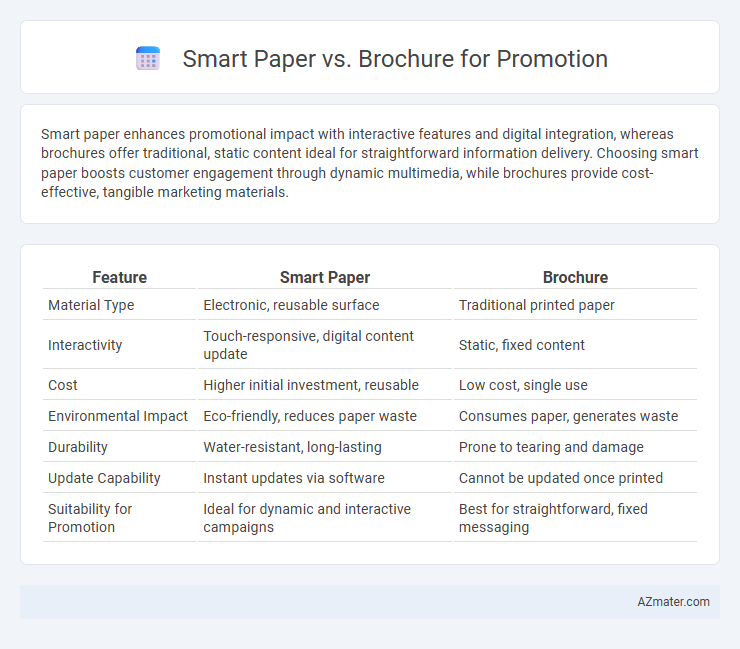Smart paper enhances promotional impact with interactive features and digital integration, whereas brochures offer traditional, static content ideal for straightforward information delivery. Choosing smart paper boosts customer engagement through dynamic multimedia, while brochures provide cost-effective, tangible marketing materials.
Table of Comparison
| Feature | Smart Paper | Brochure |
|---|---|---|
| Material Type | Electronic, reusable surface | Traditional printed paper |
| Interactivity | Touch-responsive, digital content update | Static, fixed content |
| Cost | Higher initial investment, reusable | Low cost, single use |
| Environmental Impact | Eco-friendly, reduces paper waste | Consumes paper, generates waste |
| Durability | Water-resistant, long-lasting | Prone to tearing and damage |
| Update Capability | Instant updates via software | Cannot be updated once printed |
| Suitability for Promotion | Ideal for dynamic and interactive campaigns | Best for straightforward, fixed messaging |
Understanding Smart Paper and Brochures
Smart paper integrates digital technology with traditional paper, offering interactive features such as QR codes, NFC chips, and augmented reality, which enhance consumer engagement and track user behavior. Brochures, typically printed on conventional paper, provide detailed company information and promotional content but lack real-time interactivity and data analytics. Understanding the advantages of smart paper's dynamic capabilities helps businesses create more personalized marketing strategies compared to static brochures.
Key Features of Smart Paper
Smart paper integrates digital technology, enabling interactive content like QR codes, augmented reality, and real-time updates, which traditional brochures lack. Its eco-friendly, reusable nature reduces waste compared to single-use printed brochures. Smart paper enhances customer engagement through dynamic multimedia experiences, driving more effective promotional campaigns.
Traditional Appeal of Brochures
Brochures maintain a strong traditional appeal by offering a tactile, tangible experience that smart paper currently cannot replicate, making them ideal for brand promotion at events and face-to-face interactions. Their physical presence enhances credibility and trust, providing detailed information through vibrant, high-quality prints that engage sensory perception. While smart paper integrates digital elements, brochures continue to leverage classic appeal, ensuring memorability through custom design and durable materials.
Cost Comparison: Smart Paper vs Brochure
Smart paper offers a cost-effective alternative to traditional brochures by reducing printing and distribution expenses through digital accessibility. Brochures incur higher upfront costs due to paper, ink, and physical distribution, increasing overall promotional budget requirements. Opting for smart paper can significantly lower marketing investment while maintaining effective audience engagement.
Audience Engagement: Which Wins?
Smart paper offers dynamic, interactive features such as QR codes and augmented reality that significantly enhance audience engagement compared to traditional brochures. Brochures rely on static visuals and text, limiting real-time interaction and personalization opportunities. The integration of digital technology in smart paper captivates audiences more effectively, driving higher engagement and recall rates.
Environmental Impact and Sustainability
Smart paper promotes sustainability by utilizing eco-friendly materials such as recycled fibers and embedded digital technology to reduce paper waste, contrasting with traditional brochures that typically rely on non-recyclable inks and higher paper consumption. The reduced printing and distribution demand of smart paper minimizes carbon emissions and lowers landfill contributions, making it a more environmentally responsible option for promotional campaigns. Prioritizing smart paper in marketing strategies aligns with corporate social responsibility goals and appeals to eco-conscious consumers seeking sustainable brand interactions.
Customization and Design Flexibility
Smart paper offers superior customization and design flexibility compared to traditional brochures, allowing businesses to integrate interactive elements like QR codes, NFC tags, and augmented reality features. Unlike fixed-layout brochures, smart paper adapts to dynamic content updates and personalized messaging, enhancing user engagement and targeting precision. This technology-driven approach delivers a more versatile and immersive promotional tool, tailored to specific marketing goals and consumer preferences.
Technological Integration: Smart Capabilities
Smart paper incorporates embedded sensors and NFC technology, enabling interactive and real-time tracking features that enhance user engagement and data collection during promotional campaigns. Brochures, while effective for traditional marketing, lack these smart capabilities and rely solely on static content without interactive or dynamic elements. The integration of smart technology in paper transforms promotional materials into multifunctional tools that provide measurable insights and personalized user experiences.
Measurable Results and Effectiveness
Smart paper integrates digital technology such as QR codes and NFC tags, enabling real-time tracking of customer engagement and providing measurable data on interaction rates, clicks, and conversions. Brochures rely on static design and distribution, making it difficult to quantify effectiveness or gather feedback beyond anecdotal or sales data. Businesses seeking precise ROI analysis and targeted marketing benefit more from smart paper campaigns due to their enhanced analytics and adaptability.
Choosing the Right Option for Your Brand
Smart paper integrates QR codes and NFC technology, enabling interactive and trackable promotions that enhance customer engagement and data collection. Brochures provide a tangible, traditional marketing tool, ideal for detailed brand storytelling and showcasing product information in a visually appealing format. Selecting the right option depends on your brand's target audience, marketing goals, and whether you prioritize digital interaction or physical presence to maximize promotional impact.

Infographic: Smart paper vs Brochure for Promotion
 azmater.com
azmater.com